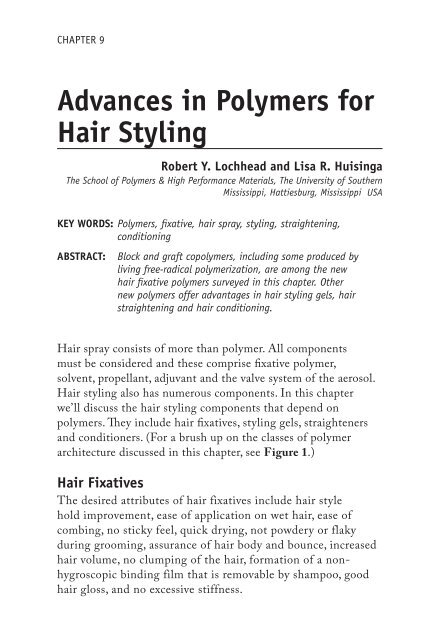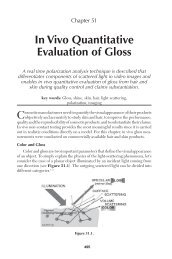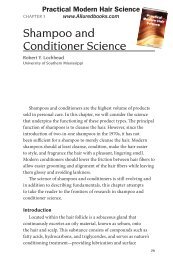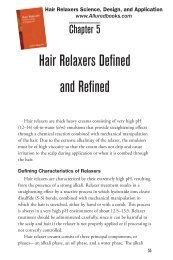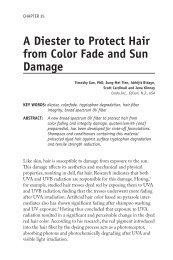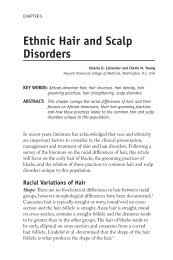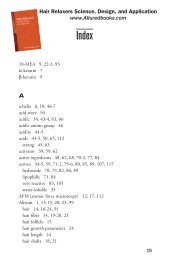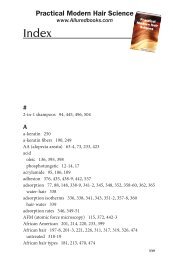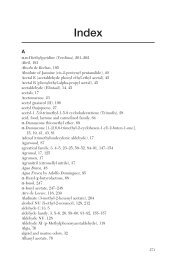Advances in Polymers for Hair Styling - Allured Books
Advances in Polymers for Hair Styling - Allured Books
Advances in Polymers for Hair Styling - Allured Books
You also want an ePaper? Increase the reach of your titles
YUMPU automatically turns print PDFs into web optimized ePapers that Google loves.
Chapter 9<br />
<strong>Advances</strong> <strong>in</strong> <strong>Polymers</strong> <strong>for</strong><br />
<strong>Hair</strong> Styl<strong>in</strong>g<br />
Robert Y. Lochhead and Lisa R. Huis<strong>in</strong>ga<br />
The School of <strong>Polymers</strong> & High Per<strong>for</strong>mance Materials, The University of Southern<br />
Mississippi, Hattiesburg, Mississippi USA<br />
KeY woRdS: <strong>Polymers</strong>, fixative, hair spray, styl<strong>in</strong>g, straighten<strong>in</strong>g,<br />
condition<strong>in</strong>g<br />
AbStRAct: Block and graft copolymers, <strong>in</strong>clud<strong>in</strong>g some produced by<br />
liv<strong>in</strong>g free-radical polymerization, are among the new<br />
hair fixative polymers surveyed <strong>in</strong> this chapter. Other<br />
new polymers offer advantages <strong>in</strong> hair styl<strong>in</strong>g gels, hair<br />
straighten<strong>in</strong>g and hair condition<strong>in</strong>g.<br />
<strong>Hair</strong> spray consists of more than polymer. All components<br />
must be considered and these comprise fixative polymer,<br />
solvent, propellant, adjuvant and the valve system of the aerosol.<br />
<strong>Hair</strong> styl<strong>in</strong>g also has numerous components. In this chapter<br />
we’ll discuss the hair styl<strong>in</strong>g components that depend on<br />
polymers. They <strong>in</strong>clude hair fixatives, styl<strong>in</strong>g gels, straighteners<br />
and conditioners. (For a brush up on the classes of polymer<br />
architecture discussed <strong>in</strong> this chapter, see Figure 1.)<br />
<strong>Hair</strong> Fixatives<br />
The desired attributes of hair fixatives <strong>in</strong>clude hair style<br />
hold improvement, ease of application on wet hair, ease of<br />
comb<strong>in</strong>g, no sticky feel, quick dry<strong>in</strong>g, not powdery or flaky<br />
dur<strong>in</strong>g groom<strong>in</strong>g, assurance of hair body and bounce, <strong>in</strong>creased<br />
hair volume, no clump<strong>in</strong>g of the hair, <strong>for</strong>mation of a nonhygroscopic<br />
b<strong>in</strong>d<strong>in</strong>g film that is removable by shampoo, good<br />
hair gloss, and no excessive stiffness.
122<br />
chapter 9 Lochhead and Huis<strong>in</strong>ga<br />
homopolymers<br />
consist of long<br />
molecular cha<strong>in</strong>s<br />
<strong>in</strong> which each l<strong>in</strong>k<br />
is an identical<br />
monomer.<br />
random copolymers<br />
consist of long<br />
molecular cha<strong>in</strong>s<br />
<strong>in</strong> which there<br />
are two different<br />
monomers and<br />
these are arranged<br />
randomly along the<br />
cha<strong>in</strong>.<br />
In Block<br />
copolymers the<br />
monomers are<br />
homopolymer<br />
blocks jo<strong>in</strong>ed<br />
together. the figure<br />
depicts an aBa<br />
block copolymer.<br />
Figure 1. Contact angle greater than 90° causes the fibers to be pushed apart<br />
In Graft or ‘comb’<br />
copolymers<br />
branches consist<strong>in</strong>g<br />
of one type of<br />
monomer are<br />
“hung” from a ma<strong>in</strong><br />
cha<strong>in</strong> consist<strong>in</strong>g<br />
of another type of<br />
monomer.<br />
<strong>Hair</strong> style hold improvement must be achieved with a m<strong>in</strong>imal<br />
amount of fixative polymer applied easily from an aerosol spray, a<br />
pump spray, a gel or a mousse. For ease of application on wet hair,<br />
the solvent must be compatible with water and the polymer must not<br />
phase-separate as water permeates the system. The fixative system<br />
must also be safe; especially upon ocular exposure or <strong>in</strong>halation. 1 For<br />
ease of comb<strong>in</strong>g, the cohesive strength of the polymer film must be<br />
less than the tensile strength and shear strength of the hair; and the<br />
adhesive bond of the film to the hair must be weaker than the shear<br />
strength of the hair. For conventional systems, sticky feel is avoided if<br />
the polymer <strong>in</strong> the dried film is immobile dur<strong>in</strong>g the time of “touch”<br />
and has <strong>in</strong>sufficient time to <strong>in</strong>teract with the stratum corneum of the<br />
f<strong>in</strong>gertips. Quick dry<strong>in</strong>g can be achieved either by judicious choice of<br />
solvent and propellant or by caus<strong>in</strong>g the system to gel. The mechanical<br />
property aesthetics of hair body and bounce, <strong>in</strong>creased hair volume<br />
non-clump<strong>in</strong>g and lack of extreme stiffness depend upon the hair<br />
matrix be<strong>in</strong>g lightly crossl<strong>in</strong>ked rather than be<strong>in</strong>g coated by the<br />
applied polymer film. The film must be non-hygroscopic; otherwise it<br />
will be plasticized by absorbed water vapor under humid conditions.<br />
Such uncontrolled plasticization leads to loss of hold.
123<br />
<strong>Advances</strong> <strong>in</strong> <strong>Polymers</strong> <strong>for</strong> <strong>Hair</strong> Styl<strong>in</strong>g<br />
Random copolymers: Dur<strong>in</strong>g the last two decades the U.S.<br />
aerosol hair spray <strong>in</strong>dustry has been driven to develop low volatile<br />
organic compound (VOC) systems to comply with the Clean Air<br />
Act. In most cases this has meant the development of “aqueous”<br />
systems <strong>in</strong> which a significant portion of the solvent is replaced by<br />
water. This has posed two ma<strong>in</strong> challenges. First, the k<strong>in</strong>etics and<br />
thermodynamics of fiber wett<strong>in</strong>g is less favorable <strong>for</strong> “aqueous”<br />
systems than the orig<strong>in</strong>al solvent-based systems (see sidebar). This<br />
results <strong>in</strong> a reduction of capillarity and a concomitant loss of hold<strong>in</strong>g<br />
power due to the <strong>in</strong>ter-fiber effects discussed above. The second<br />
challenge arises <strong>for</strong>m the fact that the water rapidly penetrates <strong>in</strong>to<br />
the hair cortex, plasticiz<strong>in</strong>g the hair and caus<strong>in</strong>g “droop” of the style.<br />
Random copolymers have a solubility parameter that is<br />
<strong>in</strong>termediate between homopolymers made from the same monomers.<br />
Twenty years ago, conventional hair spray res<strong>in</strong>s were designed to<br />
be soluble <strong>in</strong> a propellant mixture of ethanol solvent and propane/<br />
isobutane. As water was added to the polymer solution, the solvent<br />
mixture’s solubility parameter could move out of range of that of the<br />
polymer and if this happened the polymer would phase separate.<br />
The configurational entropy of mix<strong>in</strong>g <strong>in</strong>creases as the polymer<br />
molecular weight decreases and this is manifested by solubility of the<br />
lower molecular-weight polymer <strong>in</strong> a wider range of solvents than a<br />
higher molecular-weight polymer. There<strong>for</strong>e the polymer suppliers<br />
<strong>in</strong>itially responded to the need <strong>for</strong> “aqueous-compatible” polymer by<br />
merely lower<strong>in</strong>g the molecular weights of their polymer products.<br />
However, the lower<strong>in</strong>g of molecular weight also resulted <strong>in</strong> poorer<br />
film properties and the consequent loss of hold<strong>in</strong>g properties imposed<br />
limitations on the extent to which this approach could be adopted.<br />
Block and graft copolymers: Compared to random copolymers,<br />
block and graft copolymers can show dual solubility zones, with<br />
each zone correspond<strong>in</strong>g to the solubility parameter of the respective<br />
homopolymers. Homopolymer mixtures do not, <strong>in</strong> general, <strong>for</strong>m<br />
compatible blends because the large molecules have low entropies<br />
of mix<strong>in</strong>g, and <strong>in</strong> the absence of large enthalpies of mix<strong>in</strong>g, the free<br />
energies of mix<strong>in</strong>g favor segregation of the polymer mixture <strong>in</strong>to two<br />
phases – one rich <strong>in</strong> one of the homopolymers and the other phase<br />
that is rich <strong>in</strong> the other homopolymer.
124<br />
chapter 9 Lochhead and Huis<strong>in</strong>ga<br />
Each of the component “molecular blocks” of block and graft<br />
copolymers also display such segregative phase separation. However,<br />
<strong>in</strong> this case because the molecular blocks are constituent parts of<br />
the same molecule, the segregation is limited to microdoma<strong>in</strong> or<br />
nanodoma<strong>in</strong> dimensions. This limited segregation leads to polymer<br />
alloys <strong>in</strong> which glassy microdoma<strong>in</strong>s confer mechanical rigidity and<br />
rubbery microdoma<strong>in</strong>s confer rubbery and shock-absorb<strong>in</strong>g properties.<br />
These materials are thermoplastic elastomers and they often display<br />
enhanced mechanical properties. Thermoplastic elastomers comprise<br />
block copolymers conta<strong>in</strong><strong>in</strong>g rigid glassy blocks and soft rubbery blocks<br />
<strong>in</strong>corporated with<strong>in</strong> each molecule and precise control of molecular<br />
weight of the blocks produces separation <strong>in</strong>to exact micro- and nanostructures<br />
that can be “tuned” to display exact mechanical properties.<br />
Moreover, if the block copolymer is amphipathic (that is it comprises at<br />
least one hydrophilic polymeric segment and at least one hydrophobic<br />
polymer segment) it may <strong>for</strong>m films that exhibit the desired resistance<br />
to humidity but susceptibility to shampoo.<br />
wett<strong>in</strong>g of the <strong>Hair</strong><br />
Wett<strong>in</strong>g of the hair by an applied polymer solution is extremely<br />
important because capillary <strong>for</strong>ces are necessary to pull adjacent fibers<br />
together <strong>in</strong> order to <strong>for</strong>m <strong>in</strong>ter-fiber seam-welds and to cause migration<br />
of the solution to <strong>in</strong>ter-fiber cross-po<strong>in</strong>ts where the solution will be<br />
captured ow<strong>in</strong>g to a balance of Laplace pressure between the curvature<br />
at the hair-liquid <strong>in</strong>terface<br />
and opposite curvature at<br />
the air-liquid <strong>in</strong>terface. this<br />
phenomenon is commonly<br />
observed as the adhesion<br />
between the bristles when a<br />
pa<strong>in</strong>t-brush is loaded with<br />
pa<strong>in</strong>t. Dewett<strong>in</strong>g of the hair<br />
can cause the fibers to be<br />
driven apart (Figure 2) and<br />
this would <strong>in</strong>hibit migration<br />
Figure 2. Contact angle greater than 90° causes the<br />
fibers to be pushed apart<br />
of the fixative solution to crosspo<strong>in</strong>ts of the hair matrix and prevent the<br />
<strong>for</strong>mation of seam welds between fibers.
125<br />
<strong>Advances</strong> <strong>in</strong> <strong>Polymers</strong> <strong>for</strong> <strong>Hair</strong> Styl<strong>in</strong>g<br />
In this context, it is <strong>in</strong>terest<strong>in</strong>g that Dubief et al 2 have reported<br />
that the <strong>in</strong>clusion of a non-thicken<strong>in</strong>g amphiphilic block copolymer<br />
<strong>in</strong> a fixative <strong>for</strong>mulation with a conventional hair fixative polymer<br />
enhances the cosmetic and styl<strong>in</strong>g properties of the conventional<br />
polymer fixatives. The improvements are manifested by an <strong>in</strong>crease<br />
<strong>in</strong> condition<strong>in</strong>g or styl<strong>in</strong>g power without <strong>in</strong>creas<strong>in</strong>g the total<br />
polymer concentration <strong>in</strong> the <strong>for</strong>mula, or the same condition<strong>in</strong>g<br />
and styl<strong>in</strong>g benefits at reduced polymer concentration. The nonthicken<strong>in</strong>g<br />
polymer <strong>in</strong> this case is def<strong>in</strong>ed as a copolymer which<br />
when dispersed or dissolved <strong>in</strong> water leads to dynamic viscosities<br />
that are less than 0.1 Pa.s measured at a shear rate of 200 sec -1 .<br />
Examples of such amphiphilic block copolymer/ fixative polymer<br />
blends are demonstrated <strong>in</strong> Table 1.<br />
table 1<br />
examples of amphilic block copolymer/fixative polymer<br />
blends from dubief 2<br />
Fixative Polymer Amphiphilic block copolymer<br />
V<strong>in</strong>ylpyrrolidone/v<strong>in</strong>ylcaprolactam copolymer poly(styrene-b-2-hydroxyethyl methacrylate) hav<strong>in</strong>g<br />
(Luvitec VpC 55K65W, BaSF) block molecular weights: pS = 1500; pheMa =<br />
44,000<br />
V<strong>in</strong>ylpyrrolidone/dimethylam<strong>in</strong>oethylmethacrylate poly(styrene-b-acrylic acid) hav<strong>in</strong>g block molecular<br />
copolymer (Copolymer 845, ISp) weights: pS = 1500; paa = 44,000<br />
polyurethane (Luviset pUr,BaSF)<br />
ppG-1/IpDI/DMpa copolymer<br />
poly(methylmethacrylate-b-acrylic acid) hav<strong>in</strong>g<br />
block molecular weights: pMMa = 1200;<br />
paa = 38,000<br />
(avalure Ur 450, Noveon) —<br />
acrylic copolymer (avalure aC115, Noveon) —<br />
The <strong>in</strong>fluence of the block copolymer on the morphology of the<br />
bulk material and/or on the adhesion of the fixatives to the hair<br />
surface could be speculated to follow the follow<strong>in</strong>g scheme:<br />
• Block copolymers tend to exhibit morphology of separated<br />
microdoma<strong>in</strong>s, each of which is rich <strong>in</strong> one of the blocks.<br />
• Separation of discont<strong>in</strong>uous glassy doma<strong>in</strong>s <strong>in</strong> rubbery matrix<br />
would confer the properties of an elastomer


